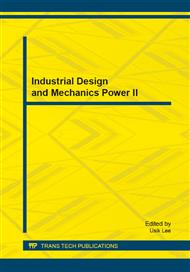[1]
Bruehlmann, Stefan, Forss, et al. Benzene: A secondary pollutant formed in the three-way catalyst, Environmental Science and Technology. 39 (2005) 331-338.
DOI: 10.1021/es049755m
Google Scholar
[2]
Liu Jinwu, Gong Jinke, Tan Ligang, et al. Numerical study on soot formation and oxidation processes in a direct injection diesel engine, Transactions of CSICE. 24 (2006) 42-49.
Google Scholar
[3]
Ambrogio, Michele, Saracco, et al. Combining filtration and catalytic combustion in particulate traps for diesel exhaust treatment, Chemical Engineering Science. 56 (2001) 1613-1621.
DOI: 10.1016/s0009-2509(00)00389-4
Google Scholar
[4]
Spezzano, Pasquale, Picini, et al. Gas- and particle-phase distribution of polycyclic aromatic hydrocarbons in two-stroke, 50-cm3 moped emissions, Atmospheric Environment. 43 (2009) 539-545.
DOI: 10.1016/j.atmosenv.2008.10.010
Google Scholar
[5]
Guilloteau, Angelique, Bedjanian, et al. Desorption of polycyclic aromatic hydrocarbons from a soot surface: Three- to five-ring PAHs, Journal of Physical Chemistry A,114 (2010) 942-948.
DOI: 10.1021/jp908862c
Google Scholar
[6]
EPA Bulleton. Draft Technical Support Document: Control of Emissions of Hazardous Air Pollutants from Motor Vehicles and Motor Vehicles Fuels, EPA420-D-00-003, (2000).
Google Scholar
[7]
Gao Junhua, Fang Maodong, Zhang Zhongrong, et al. Analysis of PAHs in particulate matter of a diesel engine by gas chromatography-mass spectrometry, Transactions of CSICE. 5 (2009) 423-429.
Google Scholar
[8]
Chae J.O. Non-thermal plasma for diesel exhaust treatment, Journal of Electrostatics. 57 (2003) 251-262.
DOI: 10.1016/s0304-3886(02)00165-1
Google Scholar
[9]
Okubo M, Miyashita T,Kuroki T, et al. Regeneration of diesel particulate filter using non-thermal plasma without catalyst, IEEE Transaction on Industry Applications. 40 (2004) 1451-1458.
DOI: 10.1109/tia.2004.836126
Google Scholar
[10]
Okubo M, Kuwahara T, Yoshida K, et al. Improvement of NOx reduction efficiency in diesel emission using nonthermal plasma-exhaust gas recirculation combined aftertreatment, IEEE Transaction on Industry Applications. 47 (2011) 2359-2366.
DOI: 10.1109/ias.2010.5615918
Google Scholar
[11]
Wang Jun, Cai Yixi, Zhao Weidong, et al. Experimental study on NTP injection system reducing diesel engine emissions and regenerating DPF, Vehicle Engine. 188 (2010) 79-82.
DOI: 10.1109/iceice.2011.5776975
Google Scholar
[12]
Wang Guihua, Liu Yungang, Li Guoxiang, et al. Effect of diesel exhaust temperature on particulate fractions of emission, Transactions of The Chinese Society of Agricultural Machinery. 36 (2005) 8-12.
Google Scholar
[13]
Zhao Weidong, Cai Yixi, Han Wenhe, et al. Simulation and experimental study of discharge power for DBD device with coaxial cylindrical structure, High Voltage Apparatus. 6 (2010) 25-28.
Google Scholar
[14]
Wang Zhong, An Yuguang, Xu Guangju, et al. Measurement method polycyclic aromatic hydrocarbon emission of diesel engine, Transactions of the Chinese Society of Agricultural Engineering. 4 (2011) 174-178.
Google Scholar
[15]
He Lijuan. Experimental study on the removal of VOCs with dielectric barrier discharge assisted catylyst, Beijing University of Technology, (2009).
Google Scholar
[16]
Du, Ch.M., Yan J.H., Li,X.D., et al. Simultaneous removal of polycyclic aromatic hydrocarbons and soot particles from flue gas by gliding arc discharge treatment, Plasma Chemistry and Plasma Processing. 26 (2006) 517-525.
DOI: 10.1007/s11090-006-9033-3
Google Scholar
[17]
Yu Liang, Tu Xin, Li Xiaodong, et al. Destruction of acenaphthene,fluorene,anthracene and pyrene by a dc gliding arc plasma reactor, Journal of Hazardous Materials. 180 (2010) 449-455.
DOI: 10.1016/j.jhazmat.2010.04.051
Google Scholar
[18]
Song Chonglin, Feng Bin, Tao Zemin, et al. Simultaneous removals of NOx,HC and PM from diesel exhaust emissions by dielectric barrier discharges, Journal of Hazardous Materials. 166 (2009) 523-530.
DOI: 10.1016/j.jhazmat.2008.11.068
Google Scholar
[19]
Ma Chaochen, Zhong Lei, Yu Shuiliang. Effect of the plasma and temperature on the chemical components of particulate matter using corona discharge, CECNet 2011-Proceedings. 2171-2174.
DOI: 10.1109/cecnet.2011.5768506
Google Scholar
[20]
Ge Yunshan, He Chao, Han Xiukun, et al. Experimental study on PAHs emissions of diesel engine fuelled with biodiesel, Transactions of CSICE. 25 (2007) 125~129.
Google Scholar


